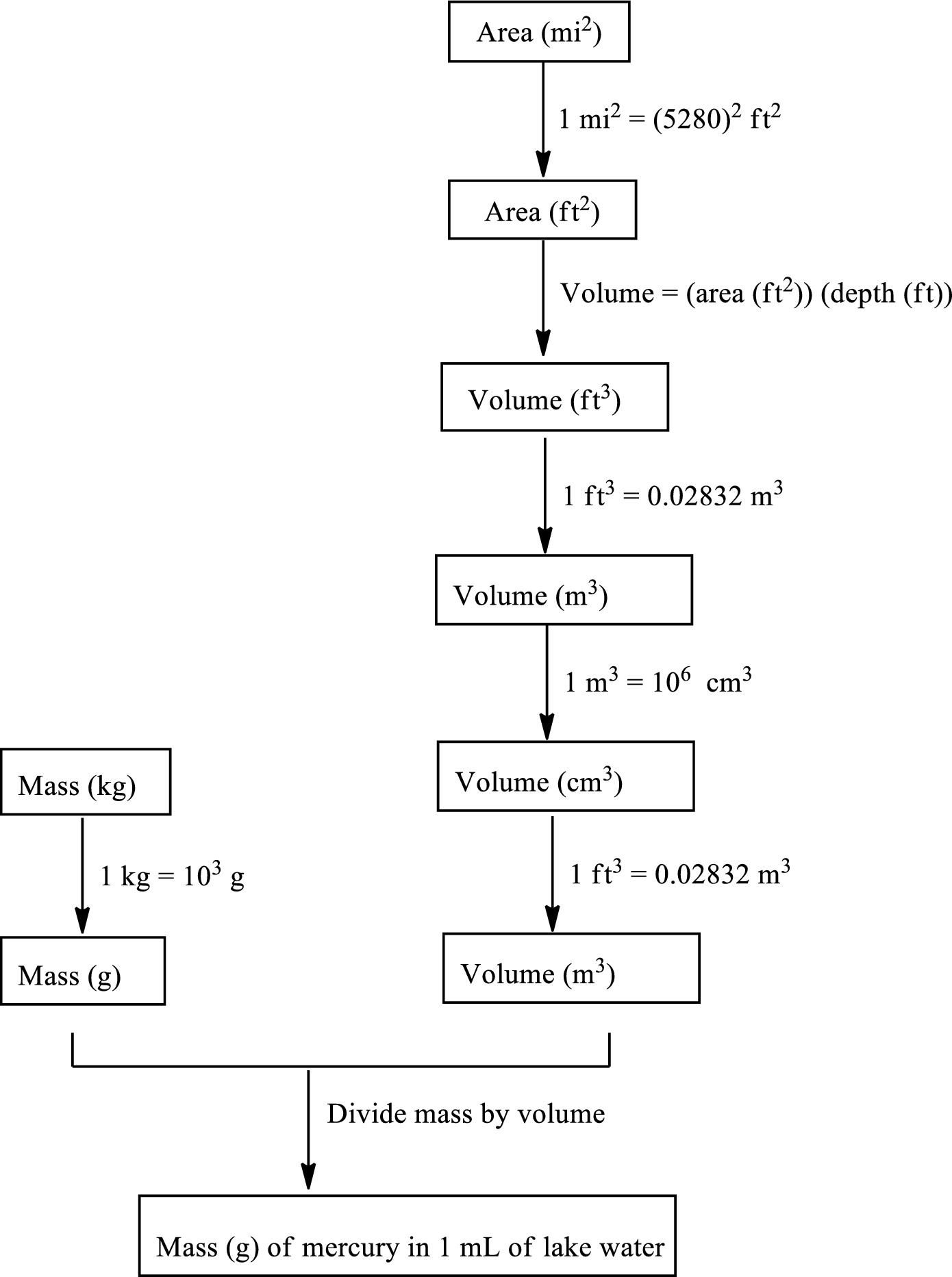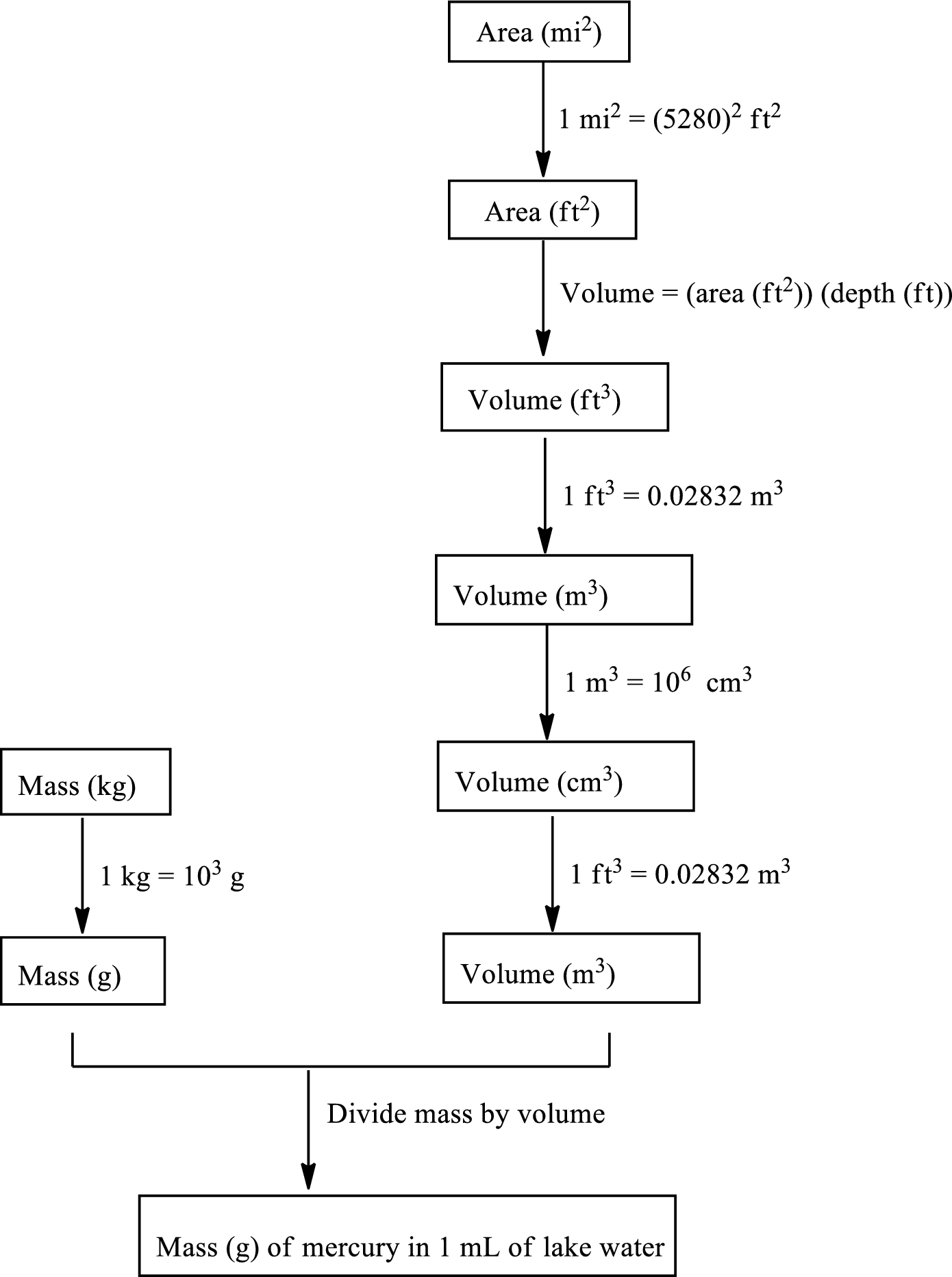
Interpretation:
The mass of mercury in grams contained in each mL of lake water is to be calculated. Also, a road map for the solution is to be drawn.
Concept introduction:
Meter square (m2) is the SI unit of the area. The English equivalent of the area is miles square (mi2). The conversion factor to convert the area from mi2 to ft2 is,
(0.3048)2 m2=1 ft2
Mass is a physical quantity and its SI unit is kilograms (kg). It is the measure of the quantity of the matter present in an object. The other units of mass are grams, milligrams.
The conversion of one unit into another can be done using a proper conversion factor. Conversion factors are the ratios that relate the two different units of a quantity. It is also known as dimensional analysis or factor label method.
In the unit conversion problems, the given information is multiplied by the conversion factors to obtain the desired information. The unit conversion can be done as follows:
(beginning unit)(Final unitbeginning unit)=Final unit
Answer to Problem 1.6BFP
The road map to calculate the mass of mercury in grams contained in each mL of lake water is as follows:

The mass of mercury in grams contained in each mL of lake water is 6.0×10−7 g/mL.
Explanation of Solution
The road map to calculate the mass of mercury in grams contained in each mL of lake water is as follows:

The mass of mercury discharged in the lake is 75,000 kg.
The conversion factor to convert the mass from kilograms (kg) to grams (g) is,
1 kg=1000 g
The mass of mercury in the lake in grams is,
Mass(g)=75,000 kg(1000 g1 kg)=7.5×107 g
The surface area of the lake is 4.5 mi2 and the depth of the lake is 35 ft.
The conversion factor to convert the area from mi2 to ft2 is,
1 mi2=(5280)2 ft2
The surface area of the lake in ft2 is calculated as:
Area(ft2)=4.5 mi2((5280)2 ft21 mi2)=1.25452800×108 ft2
The volume of the lake is calculated as:
Volume of lake(ft3)=(Area of lake(ft2))(depth of lake(ft)) (1)
Substitute 1.25452800×108 ft2 for the area of the lake and 35 ft for depth of lake in equation (1).
Volume of lake(ft3)=(1.25452800×108 ft2)(35 ft)=4.3908×109 ft3
The conversion factor to convert volume from ft3 to m3 is,
1 ft3=0.02832 m3
The conversion factor to convert volume from m3 to cm3 is,
1 m3=1×106 cm3
The conversion factor to convert volume from cm3 to mL is,
1 cm3=1 mL
The volume of the lake in mL is,
Volume of lake(mL)=4.3908×109 ft3(0.02832 m31 ft3)(1×106 cm31 m3)(1 mL1 cm3)=1.24349×1014 mL
The mass of mercury in grams present in one mL of lake water is calculated as,
Mass(g)of mercury per mL=Mass of mercury discharged in lake(g)Volume of lake(mL) (2)
Substitute 7.5×107 g for the mass of mercury discharged in the lake and 1.24349×1014 mL for the volume of the lake in equation (2).
Mass(g)of mercury per mL=7.5×107 g1.24349×1014 mL=6.0314×10−7 g/mL=6.0×10−7 g/mL
The mass of mercury in grams contained in each mL of lake water is 6.0×10−7 g/mL.
Want to see more full solutions like this?
Chapter 1 Solutions
Chemistry: The Molecular Nature of Matter and Change (Custom Package)
- Steps and explanation please. Add how to solve or target similar problems.arrow_forwardWould the following organic synthesis occur in one step? Add any missing products, required catalysts, inorganic reagents, and other important conditions. Please include a detailed explanation and drawings showing how the reaction may occur in one step.arrow_forwardThis organic molecule is dissolved in an acidic aqueous solution: OH OH A short time later sensitive infrared spectroscopy reveals the presence of a new C = O stretch absorption. That is, there must now be a new molecule present with at least one C = O bond. In the drawing area below, show the detailed mechanism that could convert the molecule above into the new molecule. Videos 849 Explanation Check C Click and drag to start dwing a structure. # 3 MAR 23 Add/Remove steparrow_forward
- ||| 7:47 ull 57% ← Problem 19 of 48 Submit Curved arrows are used to illustrate the flow of electrons. Use the reaction conditions provided and follow the curved arrows to draw the product of this carbocation rearrangement. Include all lone pairs and charges as appropriate. H 1,2-alkyl shift +arrow_forwardWould the following organic synthesis occur in one step? Add any missing products, required catalysts, inorganic reagents, and other important conditions. Please include a detailed explanation and drawings showing how the reaction may occur in one step.arrow_forwardBelow is the SN1 reaction of (S)-3-chlorocyclohexene and hydroxide (OH). Draw the missing curved arrows, lone pairs of electrons, and nonzero formal charges. In the third box, draw the two enantiomeric products that will be produced. 5th attempt Please draw all four bonds at chiral centers. Draw the two enantiomeric products that will be produced. Draw in any hydrogen at chiral centers. 1000 4th attempt Feedback Please draw all four bonds at chiral centers. 8. R5 HO: See Periodic Table See Hint H Cl Br Jid See Periodic Table See Hintarrow_forward
- Show that a molecule with configuration π4 has a cylindrically symmetric electron distribution. Hint: Let the π orbitals be equal to xf and yf, where f is a function that depends only on the distance from the internuclear axis.arrow_forward(a) Verify that the lattice energies of the alkali metal iodides are inversely proportional to the distances between the ions in MI (M = alkali metal) by plotting the lattice energies given below against the internuclear distances dMI. Is the correlation good? Would a better fit be obtained by plotting the lattice energies as a function of (1 — d*/d)/d, as theoretically suggested, with d* = 34.5 pm? You must use a standard graphing program to plot the graph. It generates an equation for the line and calculates a correlation coefficient. (b) From the graph obtained in (a), estimate the lattice energy of silver iodide. (c) Compare the results of (b) with the experimental value of 886 kJ/mol. If they do not agree, explain the deviation.arrow_forwardCan I please get help with #3 & 4? Thanks you so much!arrow_forward
 ChemistryChemistryISBN:9781305957404Author:Steven S. Zumdahl, Susan A. Zumdahl, Donald J. DeCostePublisher:Cengage Learning
ChemistryChemistryISBN:9781305957404Author:Steven S. Zumdahl, Susan A. Zumdahl, Donald J. DeCostePublisher:Cengage Learning ChemistryChemistryISBN:9781259911156Author:Raymond Chang Dr., Jason Overby ProfessorPublisher:McGraw-Hill Education
ChemistryChemistryISBN:9781259911156Author:Raymond Chang Dr., Jason Overby ProfessorPublisher:McGraw-Hill Education Principles of Instrumental AnalysisChemistryISBN:9781305577213Author:Douglas A. Skoog, F. James Holler, Stanley R. CrouchPublisher:Cengage Learning
Principles of Instrumental AnalysisChemistryISBN:9781305577213Author:Douglas A. Skoog, F. James Holler, Stanley R. CrouchPublisher:Cengage Learning Organic ChemistryChemistryISBN:9780078021558Author:Janice Gorzynski Smith Dr.Publisher:McGraw-Hill Education
Organic ChemistryChemistryISBN:9780078021558Author:Janice Gorzynski Smith Dr.Publisher:McGraw-Hill Education Chemistry: Principles and ReactionsChemistryISBN:9781305079373Author:William L. Masterton, Cecile N. HurleyPublisher:Cengage Learning
Chemistry: Principles and ReactionsChemistryISBN:9781305079373Author:William L. Masterton, Cecile N. HurleyPublisher:Cengage Learning Elementary Principles of Chemical Processes, Bind...ChemistryISBN:9781118431221Author:Richard M. Felder, Ronald W. Rousseau, Lisa G. BullardPublisher:WILEY
Elementary Principles of Chemical Processes, Bind...ChemistryISBN:9781118431221Author:Richard M. Felder, Ronald W. Rousseau, Lisa G. BullardPublisher:WILEY





